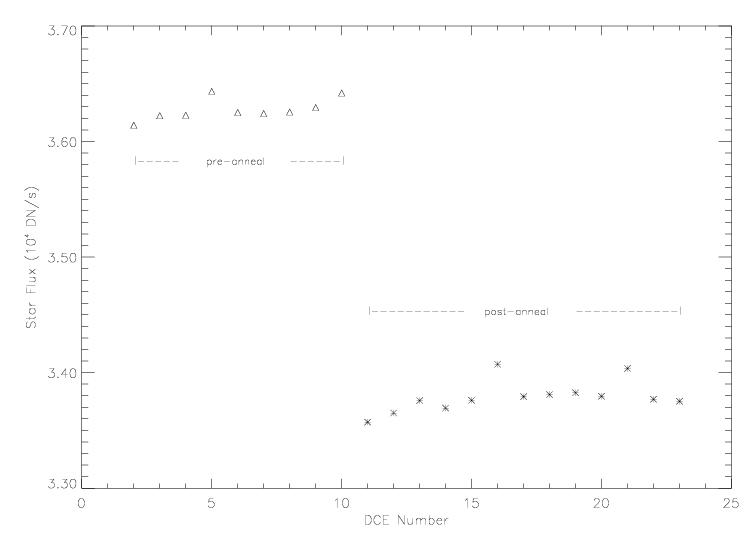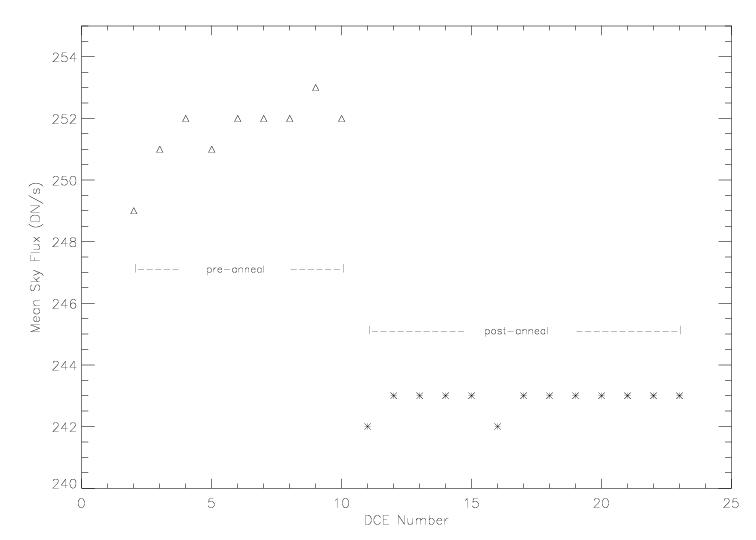
Principal:
Deputy:
Analyst:
AORKEYS:
Last Updated:
We converted the diagnostic data from the thermal anneal into temperatures and generated temperature plots. These data are compared to the temperature curves from previous anneals. These data are presented in the metatask writeup mips-2050.
We compared the 24um SUR data taken before and after the thermal anneal to look for changes in array behavior. The item of interest is the detector responsivity.
A Vrst analysis was performed on the Vrst data. In this test, the bias voltages for the 70um and 160um arrays are set to 0 mV, and then the Vrst voltages are adjusted between +5 mV and -5 mV relative to normal. A bright stim is turned on in manual mode during the test. The principle is that the array will produce a strong positive slope when positively biased and a strong negative slope when negatively biased, so the zero bias voltage point can be easily recognized. In practice, we calculate slope images and then look for this transition point.
filenames: MIPS.1.0007675648.0000.0000.01.tran_ext.fits
MIPS.1.0007675648.0003.0000.01.tran_ext.fits
DCE StarFlux SkyFlux FrameMean FrameMedian
2 36141. 249. 249.3 +/- 78.88 247.
3 36223. 251. 251.6 +/- 79.56 249.4
4 36227. 252. 252.3 +/- 79.99 250.4
5 36434. 251. 252.2 +/- 79.75 249.6
6 36251. 252. 252.5 +/- 81.07 249.8
7 36242. 252. 252.4 +/- 79.2 250.1
8 36255. 252. 252.6 +/- 79.92 250.5
9 36294. 253. 252.5 +/- 79.7 249.7
10 36419. 252. 252.5 +/- 80.38 249.9
--- Thermal Anneal happened here ---
2 33571. 242. 243.2 +/- 59.31 242.2
4 33650. 243. 243.7 +/- 59.71 243.3
6 33758. 243. 244.1 +/- 63.6 243.
8 33693. 243. 244.3 +/- 60.65 243.5
10 33760. 243. 244.3 +/- 60.03 243.
12 34072. 242. 244.3 +/- 59.79 243.1
14 33792. 243. 244.4 +/- 59.71 242.8
16 33810. 243. 244.5 +/- 59.7 243
18 33825. 243. 244.5 +/- 59.67 244.1
20 33795. 243. 244.7 +/- 59.67 243.
22 34036. 243. 244.7 +/- 59.88 244.
24 33769. 243. 244.8 +/- 59.52 243.7
26 33752. 243. 245.1 +/- 60.36 243.9
The median star and sky fluxes are plotted below:


As mentioned in previous mips-992 writeups, the proper reference for the post-anneal data is the first data point from the pre-anneal data, which is the first DCE after a bias boost DCE. In this 18-hour long campaign, there seems to be a real change in Si detector response due to cosmic ray exposure. The growth in star flux is 7%, while the growth in sky levels is about 2.5%.
The Vrst data are presented below. The filenames are MIPS.2/3.0007675648.00??.0001.01.mipl.fits. I ignored the last 72 frames in the 70um Vrst slope calculations. The 160um stim is brighter now than it used to be so I had to ignore 76 frames.
File Bias 70_1 70_2 70_3 70_4 70_5 70_6 70_7 70_8 160_1 160_2 160_3 160_4 03 Nom 60 220 -90 -40 -190 -190 -240 -200 176 -338 8 36 04 +5 -380 -380 -340 -300 -270 -220 -290 -230 -923 -1327 -545 -345 05 +4 -310 -330 -320 -260 -310 -250 -320 -270 -801 -1054 -432 -228 06 +3 -210 -210 -280 -200 -320 -240 -340 -280 -449 -722 -287 -130 07 +2 -100 -90 -190 -180 -280 -210 -300 -260 -143 -450 -133 -53 08 +1 0 60 -120 -100 -250 -220 -260 -250 147 -238 -11 17 09 Nom 100 210 -30 -100 -220 -160 -200 -220 443 -77 112 91 10 -1 200 310 60 -10 -160 -110 -200 -170 733 76 241 179 11 -2 290 370 160 30 -90 -30 -180 -100 1033 243 439 289 12 -3 380 440 250 110 60 30 -110 -90 1405 428 598 428 13 -4 470 480 340 140 140 130 20 -30 1827 629 757 610 14 -5 560 500 430 210 310 310 190 50 2330 852 958 764 15 Nom -160 -150 -220 -210 -270 -220 -270 -250 245 -79 93 98 Vrst +1.0 +1.5 -0.25 -1.5 -2.5 -2.5 -4.0 -4.25 +1.5 -0.5 +1.0 +1.25 DAC Counts +4 +6 -1 -6 -10 -10 -16 -17 +6 -2 4 +5 DAC NOM 90E 8F7 910 8E7 916 90B 920 905 97D 91C 91C 913 New DAC 912 8FD 90F 8E1 90C 901 910 8F4 983 91A 920 918